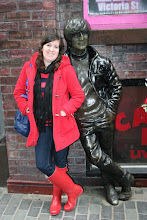It was September 17, 2009. I had packed up my life in Toronto and flown across the ocean to embark on a brand new chapter. In my mind, the most difficult part of this process was behind me. However, it turned out to be just the beginning. Now I had to find a flat and find a job.
I was living with my amazing cousin Pearl in her gorgeous house in Islington. I was adjusting to my new world, which proved quite effortless thanks to Pearl’s boundless hospitality. I was in a little transition cocoon, unaware of the hard realism that awaited me once I got out on my own. (Slight exaggeration here, for dramatic effect.)
I started searching for flats all over the city, choosing cheaper options to start with, but eventually gravitated back to the borough of Islington. The neighbourhood where Pearl lives is the London that I have always known, where I have stayed every time I visited the city. Once I fully grasped this, I concentrated my search to the immediate Angel area. It also didn’t hurt that my great friend Marge had already found a house in Islington as well. It only seemed practical to live near the two people I knew best in London.
I saw a total of seven flats before I found my current home – and only four of these were in the Angel neighbourhood. It took me three-and-a-half weeks to venture out on my own. (Compare this to the 11 interviews and four-and-a-half months it took to find a job!) Despite the apparent ease of finding a flat, I was constantly inundated with tales of the difficulties of the great flatmate search.
It would probably have been a completely different story if I had been searching for a flat on my own (a near impossible option in an expensive city like London). But I was trying to find that perfect blend of ideal location, spacious bedroom (already furnished), outdoor space and cool flatmates. I am a fastidious person who has lived alone for four years. It was sure to be a challenge.
Collecting appointments via Gumtree.co.uk (a sort of London Craig’s List), I canvassed the city by checking out flats in East Dulwich (too far), Highbury (too small), Canary Wharf (too dodgy), Tower Hill (too boring) and Queen’s Park (too many Australians).
I learned, among the many new experiences I gathered from this exercise, that going to look at a flat is a lot like going to a job interview. You are being sized up and tested to see if you make a desirable candidate. It does not necessarily matter whether you like the place and want to move in to the spare room. It is up to the flat’s already-inhabitants to decide whether you fit in.
The night that I found 15A Ecclesbourne Road, my present address, I saw a total of three flats – with Marge along to offer moral support, provide level-headedness, and prevent me from doing anything stupid. Her presence turned out to be a good idea.
The first flat I saw was in a great location, above a Japanese restaurant on Essex Road, not far from Angel tube station. But it was a tiny place and the bedroom that would be mine had previously been the living room, so there was no communal space. As Marge pointed out, while we were negotiating the narrow stairs down to the street, it would be just like living in residence.
The next appointment was also on Essex Road. It was a room inside the home of a lovely Australian couple. Their flat was clean, orderly and spacious, and was only five minutes away from Pearl’s. The flat’s main downfall was that it belonged to this couple – who were very gracious and friendly – and I was keenly aware that it was their place, and that it would never be mine.
At the end of the night I ventured down to Ecclesbourne Road (a mere four-minute walk from Pearl’s) and met Justin, my future flatmate. The house is ex-council. (Wiki: the council house is a form of public or social housing, primarily referred to in the United Kingdom and the Republic of Ireland. Council houses were built and operated by local councils to supply uncrowded, well-built homes on secure tenancies at below market rents to primarily working class people. Council house development began in the late nineteenth century and peaked in the mid-20th century.)
The house had everything I was looking for: a large south-facing bedroom, a spacious living room and kitchen, and a backyard that, with better temperatures and some sprucing up, would make a lovely place to hang out in the summer. I would be moving in with two British boys (Justin from Manchester and Arthur from Oxfordshire), which offered a definite upside. For one, living with girls causes needless drama (2002 at Queen’s can attest to that). And, after looking at flats crammed with Australians, Kiwis, Japanese and Eastern Europeans, I had decided that I wanted to live with some Brits. After all, living with other ex-pats was not exactly a very UK experience.
I moved in on October 10, with some help from Ikea and Pearl, and have been here ever since. It is a fantastic house, with great flatmates, in a perfect location (15-minute walk to Angel tube station and six buses to all parts of the city almost right outside my door). The shape of my London life was starting to develop a discernable quality. I was starting to recognize myself again. Now, all I had to do was find a job.


No comments:
Post a Comment